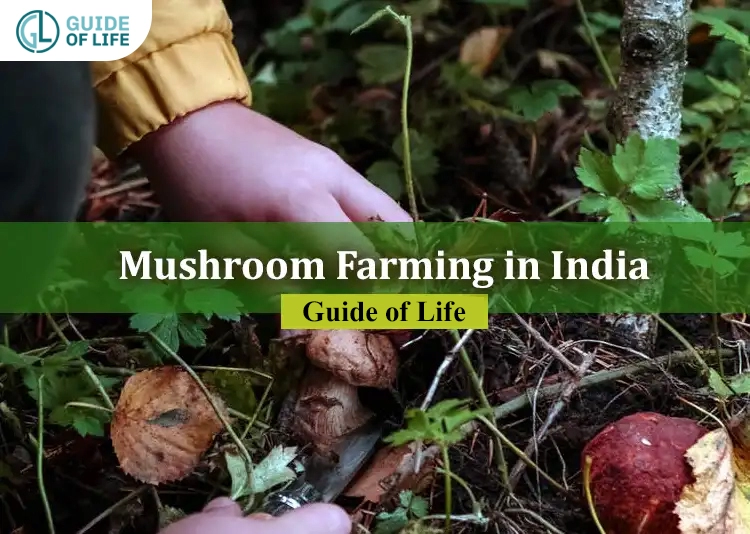Mushroom Farming in India | Guide of Life

Mushroom farming in India is a part of the Fungi species. It is also a high protein source like lysine and full of nutrition. It has eight mushrooms: white button mushrooms, portobello mushrooms, shiitake mushrooms, oyster mushrooms, enoki mushrooms, shimeji mushrooms, porcini mushrooms, and paddy straw mushroom.
Mushrooms consist of lots of minerals and vitamins. Moreover, it is also fat-free and rich in antioxidants. Not only but also have several medicinal properties.
Also Read: Types Of Farming in India | Description And Its Characteristics
Different Types of Mushrooms
These are the different types of mushroom produce in India.
Paddy Straw
In 1940, Paddy straw mushroom was first cultivated in India. It is also famous like white button mushrooms. These mushrooms are rich in fiber, vitamins, and protein and suitable for controlling diabetes.
White button Mushroom
White button mushroom is easily found in Indian markets, and it is mild in taste. It can be primarily used in soup, salads, and pizzas. Also, these mushrooms are not so healthy.
Portobello Mushrooms
Portobello mushroom is locally found in Europe and North American grasslands, commonly eaten in the world. It is famous because of its size, meaty texture, and earthy flavour.
Shiitake Mushroom
Shiitake mushrooms are very popular in the world because of their savory taste and various health benefits. Moreover, they are also famous for medical properties also used as a powder in herbal pharmacies.
Oyster Mushroom
Oyster mushrooms are consumable mushroom because it is most common and versatile. This mushroom is a good source of nutrients, protein, vitamins, and minerals; it has many health benefits.
Enoki Mushroom
Enoki mushrooms are mainly used for East Asian cooking and food. We can also call them golden needle mushrooms—also, it's used for salads, pasta sauces, soups, and sandwiches.
Shimeji Mushroom
Shimeji mushroom is also famous for brown beech mushroom, buna shimeji, and clamshell mushroom, and they grow on dead beech trees. Sauces, soups, stews, and stir-fried foods are the best dishes of shimeji mushrooms.
Porcini Mushroom
Porcini mushroom is famous in Italian Cuisine. These mushrooms are large with a cap, and their diameter is 12inches. For eggs, pasta, meat, and vegetarian dishes, and sauces, it is used mainly.
Also Read: How Can Organic Farming Help to Protect the Environment?
Indian Synopsis
In 2009-2010, India produced 40,600 tonnes of mushrooms. Majorly mushroom farming in India happens in these states; Haryana, Uttar Pradesh, Punjab, Jammu & Kashmir, Himachal Pradesh, and Rajasthan. Fifty percent of mushroom produce in Punjab from total manufacturing.
It is usually grown indoors because it is a non-traditional cash crop; also, it needs to have controlled environmental conditions. Button mushrooms were grown in the temperate region, and in the tropical and subtropical region Milky, Paddy straw, and Oyster mushrooms were grown.
Button mushrooms gathered two to three crops per year, but it gathered only one crop per year for seasonal Button mushrooms.
In the 1990s, India contributed only one percent that is the least in World trade, a total of 11000 tonnes exports from India priced at 66 crores, but we know India can export more. Mainly Mexico, the U.S., and Israel import mushrooms from India.
Two forms of mushroom exported by India are fresh and prepared. India's per capita utilization ( 20-25 g) is very low compared to the U.S.A. and Europe ( 2-3 kg).
Most mushrooms are consumed as fresh in the world. Moreover, the filtered mushrooms are mainly in a frozen form, dried, and canned. Mushrooms have a short life-span; that's why it has to be filtered into 24hrs.
85% white button mushrooms produced from the total production of mushrooms. For technical support, there is a nodal institute of mushroom production India NRCM (National Research Centre of Mushroom). The foundation of NRCM is for the growth of mushroom production.
Mushroom is a very nutritious food, and it's important to be popular because it helps eliminate malnutrition among childrens, increase protein, and increase employment opportunities. Mushrooms also contain medicinal quality, so it also increases global trade.
Also Read: 9 Plus Reasons Why Organic Farming is Good for Future Generations in India
Technological Detail of Mushroom Production
- Manufacturing process
- Preparing mushroom seeds: mushroom seeds are easily obtainable in the market.
- Preparing compost: There are several mixtures of compost that can be organic or inorganic. Wheat and paddy straw have very few nutrients, so we can also use them. We can also use horse dung as an inorganic compost. Knowing the quality of mushroom must check its color should be dark brown, slight greasiness, 65-70% moisture, and ammonia-free.
- Spewing: it signifies mixing compost with spawns. Mainly three policy used for mixing compost with spawns;
- Layer spewing: when spawning occurs in different layers means when we divide compost into equal layers and spread spawns in each layer.
- Surface spewing: On the surface, 3 to 5 cm mixed compost. We have to spread the spawn all over the surface and cover it with compost.
- Through spewing: compost is mix with spawns and then pressed. For 35kg of compost, one bottle spawn is enough. Mainly 2 percent of formalin sprinkled over their surface.
To increase mushroom farming in India, the government or NRCM needs to create the best policy for mushroom farming because mushroom farming is very nutritious. It is essential for increasing trading in the world.
Also Read: 10+ Best Organic Fertilizers for Vegetables
In conclusion, mushroom farming in India, detailed by Guide of Life, reveals a rich tapestry of variety and nutrition. As we explore the diverse types of mushrooms, their health benefits, and the intricate farming process, it becomes clear that this isn't just about cultivating a delicious delicacy. It's about fostering health, generating employment, and expanding global trade. Join us on this enlightening journey into the world of mushrooms, where the magic extends far beyond the plate.

